People should resolutely defend their own privacy based on the legal regulations to create their own exclusive information and space with the sense of controllable happiness as the resting place in the noisy world.
Privacy can be defined as “the right of individuals to retain their own data and protect them from being monitored and recorded without authorization”. In the actual application, the chain transaction can be correlated with the user’s real identity in many ways, so the user’s privacy cannot be effectively protected.
The significance of privacy for cryptocurrency and encryption economy is as follows:
- Firstly, the privacy can ensure the substitutability of cryptocurrency. In theory, each currency unit should be equivalent. Transaction transparency and traceability are one of the main advantages of bitcoin and other cryptocurrencies in the market; however, these features will affect the substitutability. For instance, if some major exchanges publish a blacklist of cryptocurrency addresses which they refuse to receive, then everyone needs to carefully check their transaction records to avoid any connection with the addresses on the blacklist. Thus, the transaction costs will be increased and the circulation values of cryptocurrency will be reduced.
- Secondly, privacy is an essential element for effective operation of free market. If the business information can be easily seen by competitors or customers in the blockchain, the product pricing and market competition will become extremely difficult.
- Finally, we must also notice that privacy is vital to individual security and personal dignity, because nobody wants their lives to be peeked arbitrarily.
The privacy currency can hide all or part of the transaction amounts, the information of senders and receivers, restore the substitutability of cryptocurrency and protect the privacy of the holders. With the further development of cryptocurrency market, the ecology of private currency has also gradually grown.
At present, there are three major currencies, Monero, Dash and Zcash in the market, which have certain applications in the fields of daily payment, privacy transactions, asset storage and even underground transactions.
In addition to detailed analysis of chain transaction of the private currency, this article will also discuss the applications as well as the development of private transactions. The analysis will be focused on the market and applications with the following core points:
- At present, the biggest application of private currency is to use the original token as a means of payment. Dash plays a leading role in mobile payment and merchant number.
- At present, the daily transaction of mainstream private currency has been more than 100 million dollars. Except for Monero which only allows shield transactions, most transactions are not conducted in a private way. Dash even expands non-private market such as micropayment in Venezuela.
- The application of private currency depends on not only the advanced privacy technology, but also the marketing and community operations. The transaction volume of Zcash, whose advanced privacy technology is well-recognized, is gradually decreasing.
- Although it’s generally recognized that private currency is mainly used in markets where supervision is absent, the most popular cryptocurrency payment in underground trading websites is still bitcoin, followed by Monero, while other private currencies have not been applied yet.
Contents
- Mainstream Private Currency
- Zcash Private Trading and Enterprise-level Application
- Dash Second-Level Masternode Network
- Monero Privacy Trading and Algorithm Upgrade
- Typical Applications
- Other Private Currencies
- Prospects
- Reference
Mainstream Private Currency
At present, the mainstream private currencies include Monero, Dash and Zcash. The market values of the three are ranked the Top 25 with high reputation in the industry. At present, the mainstream private currencies are mainly applied in the Currency Function.
- Monero is self-defined as: Private Digital Currency;
- Dash is self-defined as: Instant transactions and micro-fees. Any amount, anytime, anywhere;
- Zcash is self-defined as: Zcash is a privacy-protecting, digital currency built on strong science.
Monero and Zcash highlight the concept of private e-currency, while Dash highlights the real-time transaction, low commissions and global payment based on its marketing strategy. It is worth noticing that Dash used to call it Darkcoin due to its private trading function, but now it’s difficult to find any expression on its privacy at the official website. The marketing strategy of Dash also naturally promotes more merchants for supporting and the number of Dash partners is much higher than that of Monero and Zcash. Please refer to the following chart for brief introduction of the three currencies:

Since the three are based on the monetary function, their performance can be observed by the number of transactions, the volume of transactions, the number of active addresses and the median of transaction amount. The following data come from Coin Metrics, in which we can find:
- Dash’s active addresses and transactions are significantly higher than that of other private currencies, but the feature of micropayment makes the median of transactions amount and volumes lower than that of Zcash (Monero’s transaction amount is invisible).
- According to the overall trend of trading in the past year, Dash shows an upward trend, Monero remains stable while Zcash declines significantly.
According to the definition of coinmetrics, the active address refers to an address which initiates transactions within specific time. The number of Dash active addresses has risen significantly since January, 2019, which is inseparable from its marketing strategy (to be discussed later), while the number of Zcash active addresses has dropped significantly since June, 2018. The number of Monero active addresses had been stable at around 3W, which is almost equivalent to that of Zcash currently.
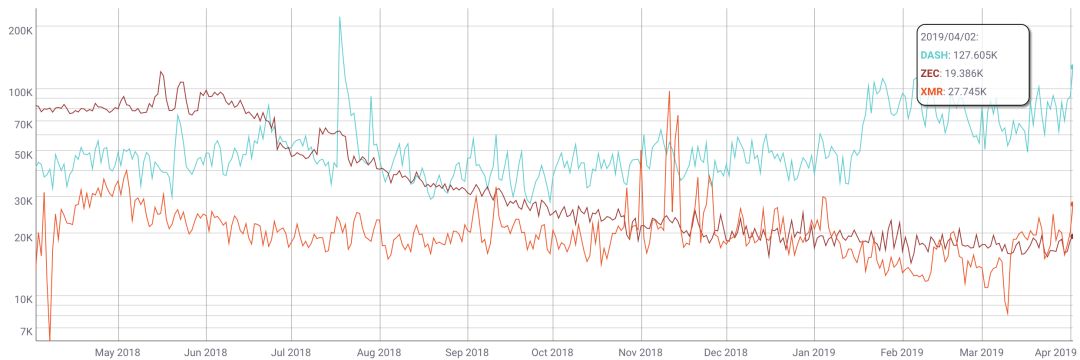
The transaction number of Dash continued to exceed that of Monero and Zcash, especially it has increased significantly since September 2018, while that of Zcash has dropped significantly since July 2018 and Monero has remained stable. Nowadays, the transaction number of Dash is about four times as many as that of Monero and Zcash.
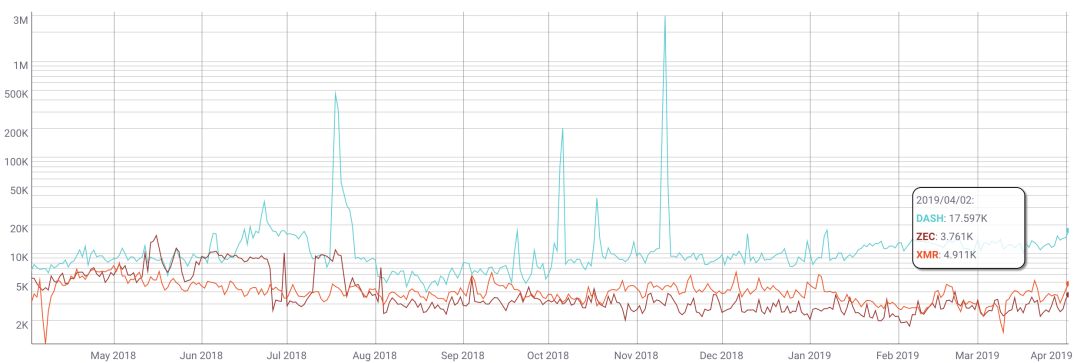
Although the transaction number of Zcash keeps declining, the median of transaction amount (this indicator can better reflect the concentration trend of the transaction amount) ranks the top among the three. Since July, 2018, the median of Zcash transaction amount has exceeded that of bitcoin. It kept increasing gradually and now has reached US$519, and the average transaction amount has even reached US$24,000. Nowadays, the median of Dash transaction amount is US$22, which is in line with the market positioning of micropayment.
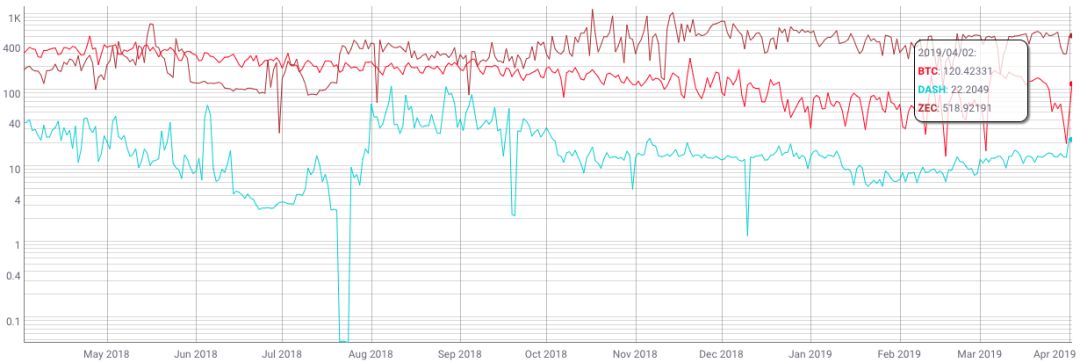
The trading volume of Zcash and Dash has maintained the trend of shock rise since January, 2019. Nowadays, the daily trading volume of Zcash has reached US$90 million and Dash has reached US$45 million. The trading volume of Monero cannot be counted due to invisible transaction amount. In general, the daily trading volume of the mainstream private currencies has reached more than US$100 million.
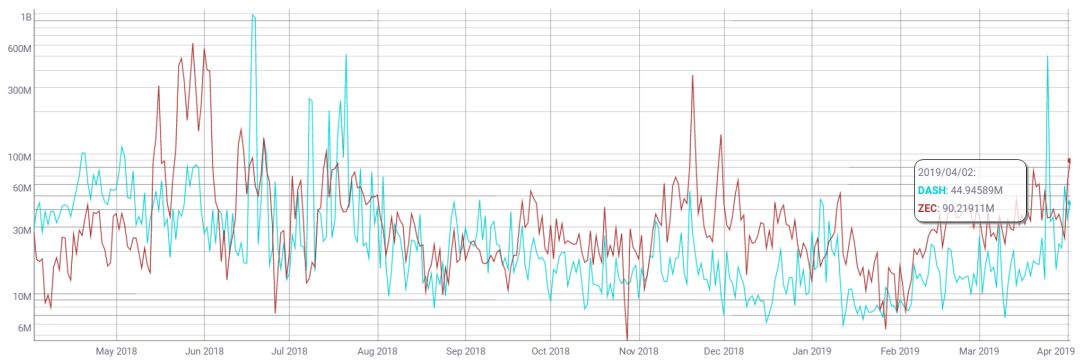
The technical features and applications of Zcash, Monero and Dash are different with each other, so they will be discussed in detail as follows.
Zcash Private Trading and Enterprise-level Application
Zcash adopted zk-SNARKs zero-knowledge to verify the transaction validity for the first time. The Sapling network upgraded on October 29, 2010 significantly improved the efficiency of shield transactions. The users can choose transactions with public address or private address. Shield transactions are not the default route and the number of users’ actual private transactions has not increased yet (since the coinbase transaction requests the private address to be sent, there are less private transactions among users actually) and the ratio has continued to decline.
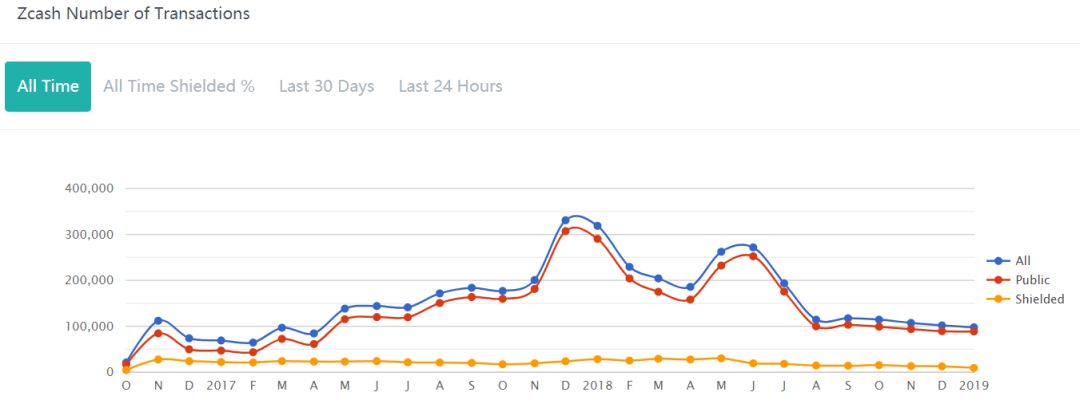
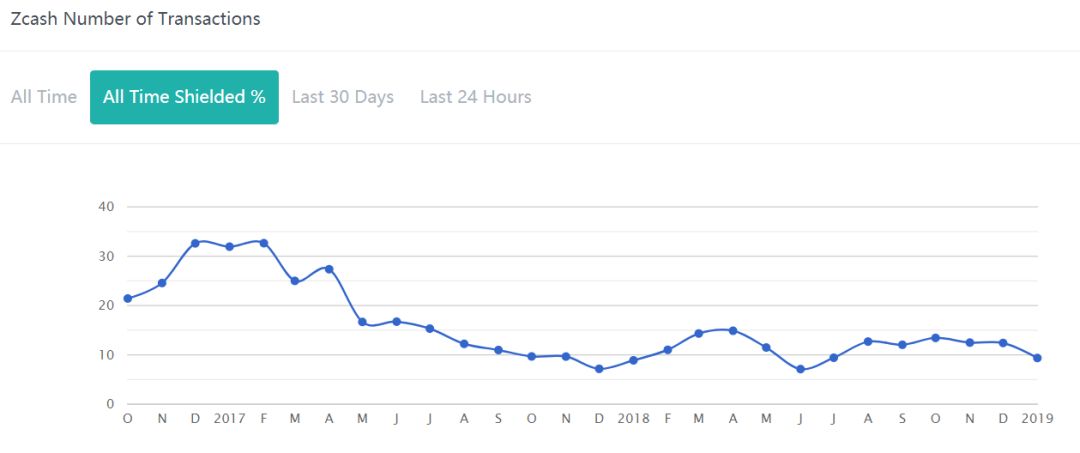
Complete shield transaction (Shielded to Shielded) accounts for only 0.4% of private transactions and only 2 wallets can support shield transactions. One is the officially-released Linux command interface while the other is the desktop wallet. The limited choice of wallet and poor experience have greatly limited the development of Zcash shield transactions. In contrast, many wallets support the monero.
JP Morgan’s enterprise-level distributed ledger and smart contract platform Quorum adopted zk-SNARKs zero-knowledge proof technology in 2017 to ensure the privacy of the transaction. In addition, Komodo and Horizen have applied zk-SNARKs for encryption of chain information.
It should be noted the compliance transaction of Zcash in the United States has been ranked the top of other similar projects and it’s highly accepted on digital asset trading platform operated by the SEC and the New York State Department of Financial Services (NYDSF). These trading platforms have rich institutional investment channels in the traditional financial system, which mainly focus on attracting HNW users and institutional investors.
Dash Second-Level Masternode Network
Dash supports three transfer methods —- which resembles bitcoin ordinary transfer, real-time transaction and shield transaction. The real-time transaction and shield transaction are conducted in the second-level masternode network: the real-time transaction is realized through the voting arbitration and broadcasting in the masternode network. The transaction can be confirmed without being packed by the mining workers and the delay is shortened to just one second; the shield transaction is conducted through currency mixture in the masternode network.
Real-time transaction and shield transaction in the masternode network have greatly improved the micropayment experience. The application of Dash in micropayment will be discussed in detail as follows.
Meanwhile, the financial management applications derived from Dash masternode are worthy of being focused on. As of April 8, 2019, there are currently 4491 masternodes without frequent transactions: the payment interval per node 4635.5 blocks (more than 8 days), an average of 0.2 Dash per node every day, a mortgage of 1000 Dash per node with 7.56% annualized return.

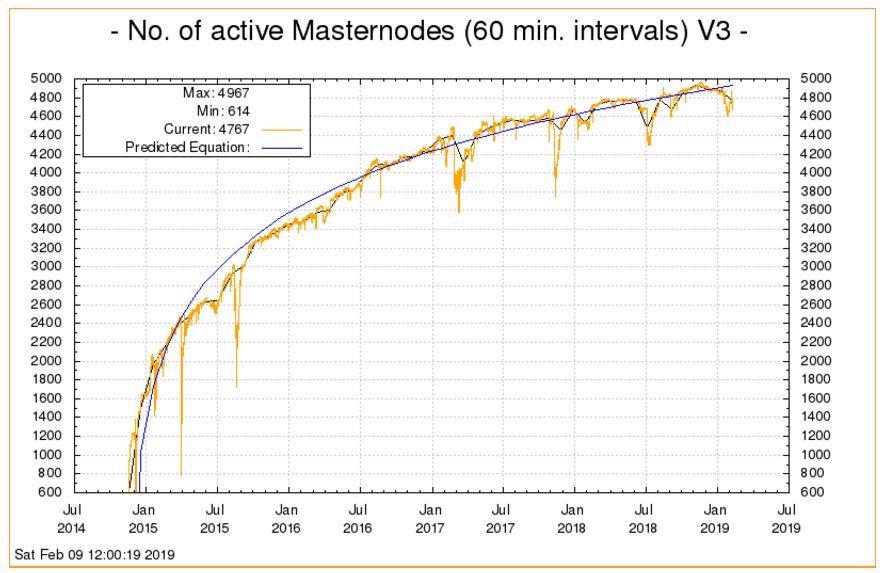
Monero Privacy Trading and Algorithm Upgrade
With only full privacy trading, Monero has the best anonymity in terms of traceability: the sender address and transaction amount are invisible, the address which can be viewed is one-off temporary one and the past transactions cannot be traced.
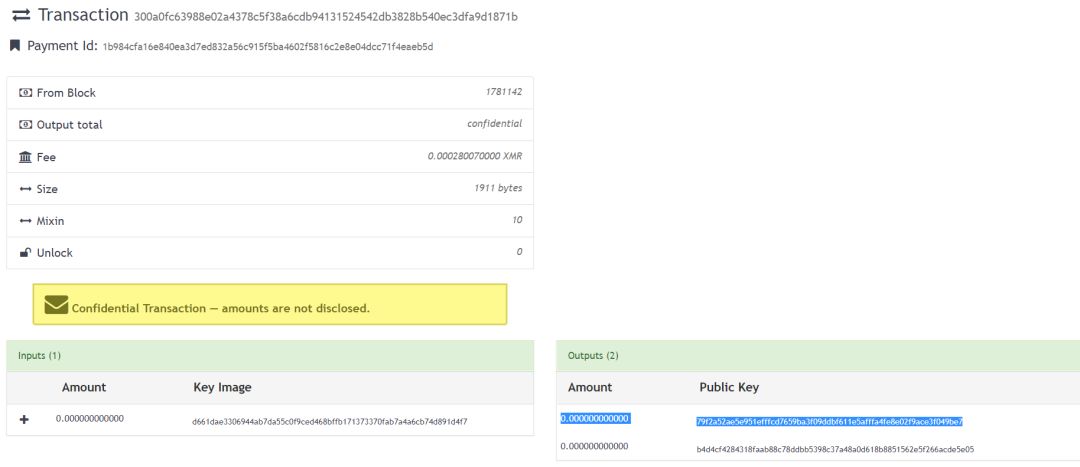
Monero conducted a hard fork upgrade of PoW algorithm on October, 18, 2018 and the block sizes and transaction fees were greatly reduced, but there’re no obvious changes of trading volume.
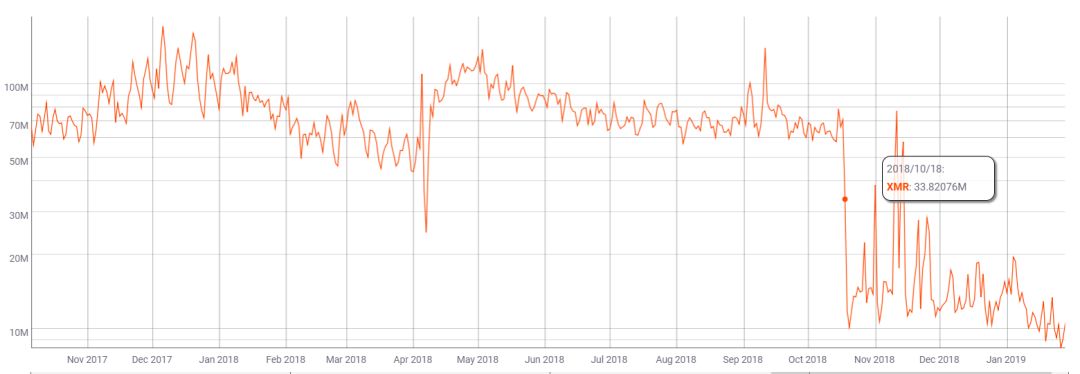
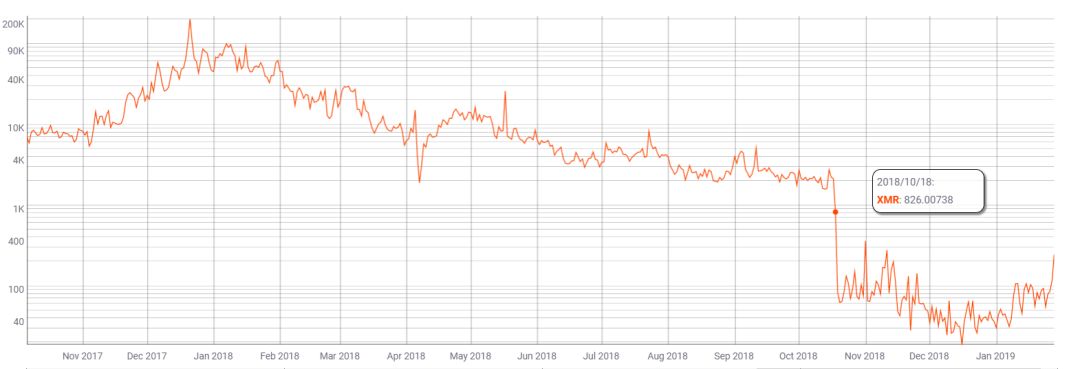
Typical Applications
The typical applications of private currency include:
- Underground Transaction
- Offline Micropayment
Underground Transaction
As for the applications of private currency, the underground transaction is the most well-known. Due to the privacy of underground transactions, it’s hard to collect the complete transaction data. Therefore, the cryptocurrency supported by the top eight underground trading websites is selected as the reference indicator in this article. According to the chart below, all underground transactions support Bitcoin payment, followed by Monero, and some support Bitcoin Cash, Ethereum and Litecoin, but other private cryptocurrencies have not been applied. Due to the most extensive consensus on Bitcoin as well as its way of mixed-coin trading to enhance transaction privacy, Bitcoin has become the most widely supported cryptocurrency in underground transactions.
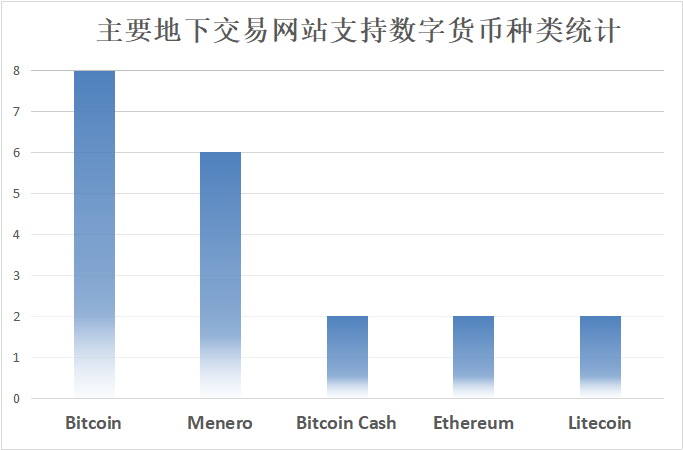
Offline Micropayment
As for the application of private currency, Dash offline micropayment should be noted. In this case, the Dash community and marketing team have played an important role in promotion of this application.
Since 2018, the number of Dash merchants has grown rapidly from less than 1,000 to nearly 5,000 in January 2019, with almost half in Venezuela.
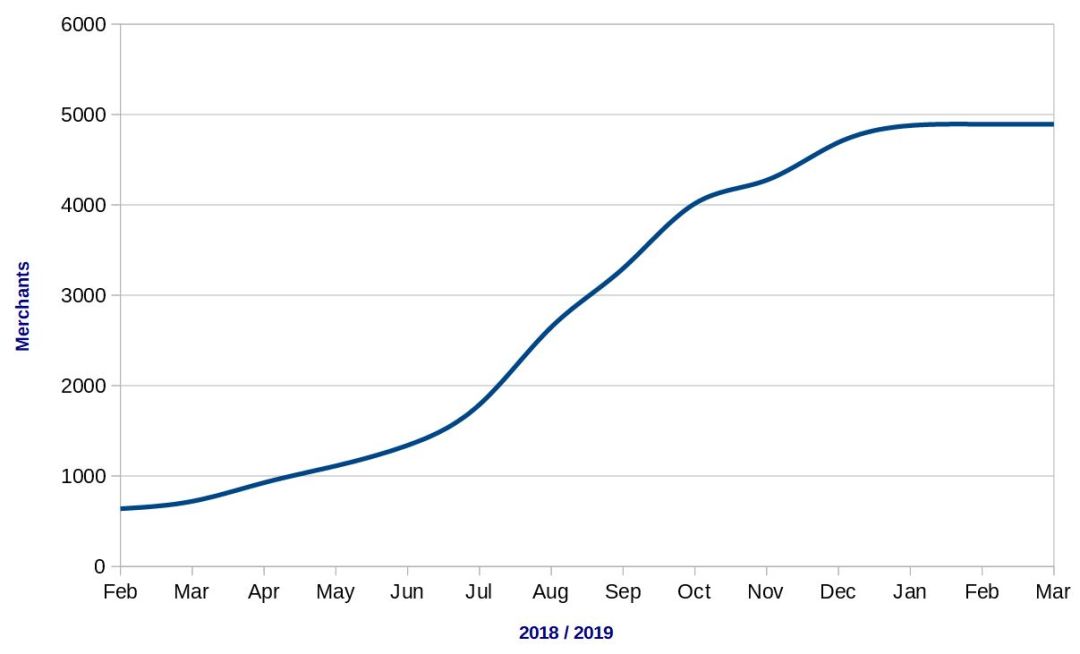
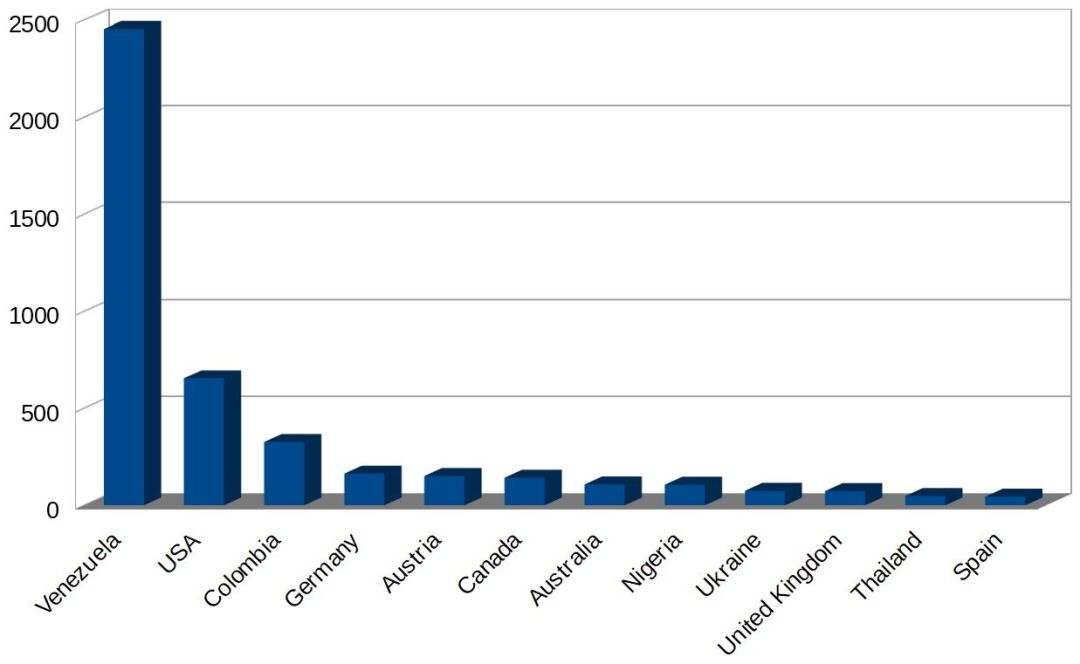
Venezuela is facing serious inflation all the time and the overall inflation rate in 2018 has reached millions of times, which creates opportunities for cryptocurrencies in local applications.
In such background, Dash Force conducted key market promotion in Venezuela. Dash Force is the first DAO out of Dash Core whose team is funded by Dash masternode. Since February 2017, Dash Force can release about 60 articles per month on the promotion of Dash application. Its promotion strategy in Venezuela focuses on the following three points:
- Obtain Dash easily
- Store Dash safely
- Trade Dash conveniently
With this purpose, Dash is committed to cooperating with the cheap mobile phone brand Kriptomobile for the first time: pre-install Dash wallet with a small amount of Dash to attract users. From the end of September to mid-December, Dash has sold more than 66,000 Kriptomobile phones at the price of less than US$100 each. With Kriptomobile, users can easily obtain and store Dash.
To trade Dash conveniently, more merchants need to accept Dash. Therefore, Dash not only cooperates with local gift card companies such as Bitrefill and Church’s Chicken, but also continuously expands the offline micro-merchants. The local business has been expanded rapidly to as many as 2,500 merchants and 10% of activities using Dash were launched to motivate users in January.
Joel Valenzuela, working staff of Dash Force in Venezuela, concluded:
- Step 1: Encourage small merchants to use encryption technology
- Step 2: Encourage highly recognized brands to use encryption technology
- Step 3: Provide extra rewards for application of encryption technology (current stage)
- Step 4: Encourage merchants to pay cryptocurrency as salary
- Step 5: Massive application / innovation of US Federal Reserve / realize economic freedom and currency health
As a result, it’s discovered that the trading volume of Dash has been increasing slowly since August, which maintained at about 6K averagely in August and 11k averagely from January to April. That’s in line with Dash’s promotion time in South America (starting in August). At the same time, the average transaction amount is more in line with the concept of micropayment, which has been gradually reduced. The Dash experience in Venezuela will inevitably lead to its promotion in other countries. At present, Zimbabwe, a neighboring country of Venezuela, has also started quick development and become the third largest country in terms of merchant number.
As for the promotion of emerging technology by DAO and cross-border means, Dash Force becomes an interesting case of blockchain application.
Other Private Currencies
In addition, there are other emerging privacy currencies that deserve our attention, such as Beam, Grin, etc.
Beam and Grin
Recently, the MimbleWimble privacy protocol has attracted wide attentions and two relevant private currencies, Beam and Grin, have been online consecutively. (See also: Introduction of New Cryptocurrency Grin and Beam Based on MimbleWimble)
Now, Grin’s market value and trading volume are greater than that of Beam. According to its monetary policy, “a new Grin is produced every second”, which can keep inflation constant (although gradually approaching 0%). That’s different from other cryptocurrencies such as Bitcoin, which has quite strong deflation. In short, the Grin team aims to stop the hoarding behavior. In contrast, the supply of BEAM is fixed at about 263 million which will be exhausted within 133 years as a limited supply of deflationary tokens.
In terms of transfer experience, Grin wallet sends transaction file to conduct blockchain transactions by means of interactive signatures even without address. The transaction can be canceled if it’s not confirmed. There are potential security risks in current transfer process:
- One option for interactive signature is connection to the other party’s IP address, in which the privacy may be involved;
- Interactive signature makes intermediary attack possible: a safe communication channel is necessary.
Beam conducts address conversion so that permanent address can be selected. Users can use more traditional way to conduct transaction instead of only an IP address like Grin.
Even a permanent address is adopted, it also requires the recipient’s wallet to be online for payment acceptance. For this purpose, Beam introduced a concept of “unilateral payment”: the recipient releases a set of UTXOs which the sender can use to create transaction. Assigning different values for these UTXOs, the recipient allows the sender to set any number for the amount.
Since Beam and Grin have just been online, their subsequent effects remain to be further observed.
Komodo
Being forked from Zcash, Komodo’s average daily trading volume has reached 9350 within 7 days (from March 28 to April 3) and its average daily active address is 1171. The number of transactions ranks in the first echelon of the private currencies, slightly lower than Dash. Komodo splits the transactions and send to a series of zk-SNARK addresses, which then send to the specified receiving addresses to ensure shield transaction tracks. Meanwhile, since Komodo public chain provides decentralized exchange, it can also provide privacy service for decentralized transactions.
One of current Komodo applications is: BarterDEX, a decentralized exchange. BarterDEX has conducted a total of 115,960 cross-chain atomic exchanges, but the number of transactions in the past six months has basically approahced zero. For other applications, Komodo tends to cooperate with other legal currency gateways, such as BitPanda, Netcoin, CoinFlip, CoinSwitch and Peer2Group for the sake of application promotion (as means of payment).
Although Komodo can meet the requirement of private transactions, it also faces the same dilemma as Zcash: due to full nodes operation, the cost of private transaction is very high, which results in low percentage of its application. Meanwhile, the application promotion only aims at decentralized exchanges and legal currency gateways instead of private transactions.
Verge
Verge shields user’s IP by means of Tor and I2P tunneling technology. Meanwhile, it adopts the Dual-Key Stealth Addressing technology to ensure the transaction paths of both parties invisible. Verge’s daily average Tx is around 2000, which is slightly lower than that of Merono and Zcash. The privacy technology adopted by Verge has always been criticized and they’re developing the ring signature currently.
Verge aims to become a payment tool. It has listed 143 kinds of payments on the official website and the most well-known included Pornhub, Netcents, etc., which had attracted great attention. However, Verge suffered two 51% attacks (on April 4 and May 14) in 2018, which made its influence and market value worse than before.
PIVX、Zcoin、Bytecoin
Based on Zerocoin Protocol technology, both PIVX and Zcoin are dedicated to private payment. The current daily average Tx of PIVX is between 500 and 1000. It has listed 116 merchants accepting PIVX on the official website and recruited a total of 17 global PIVX ambassadors for commercial promotion all over the world (similar to Dash strategy). Zcoin’s Tx is maintained below 500. On the official website and Roadmap, we have only found its cooperation with PolisPay, a debit card company.
As the first private chain based on CryptoNote technology, Bytecoin was released in 2012 with an average daily Tx of around 1,000. On its official website, it’s listed 17 supporting merchants as well as a gaming website.
Prospects
If privacy technology can only be used for payment and underground website transactions, the applications will inevitably be very limited. Some prospects on the future development of privacy technology are as follows.
Financial Privacy
Financial Privacy is a universal demand for financial transactions and the inevitable outcome of market economy centered on financial market in modern times. However, the shield blockchain transactions never mean the protections on privacy. Some chain data analysis companies such as Chainalysis has posed great challenge to financial privacy on the blockchain.
Financial privacy can protect the specific property of the users. With the development of blockchain, by matching the user’s personal information with the trading information on chain, it’s possible to trace all the transactions in the past and in the future. Thus, they can not only be revealed and resold for commercial purposes, but also be used for blackmail or extortion. Taking the intrinsic property into consideration, the property right of financial privacy should be under good protection.
Meanwhile, financial privacy also demands for legal norms to better meet financial transaction and regulatory requirements with the functions of layered encryption or external third-party audit.
Future of Private Transactions
In the future, private transaction may not be the function of specific currency. By means of privacy protocols such as AZTEC Protocol and Zether, the mainstream cryptocurrency can also realize the private transactions.
On Ethereum, AZTEC Protocol uses Dai as a case to realize the private transaction of ERC20 tokens by means of zero-knowledge proof technology: users can send reliable transactions on the public chain without revealing transaction information.
Zether is a privacy protocol of Ethereum Smart Contract Platform to conduct private transaction with ZTH tokens based on the new zero-knowledge proof mechanism. Theoretically, all the chains supporting smart protocol can conduct the project. The team has already conducted initial implementation and testing on Ethereum now. Zether has also released the detailed technical documentation which was written by Benedikt Bunz, the designer of Bulletproofs.
Based on the aforesaid privacy protocol, the mainstream cryptocurrency can also realize private transactions and make the private transaction an option for users. It will greatly expand the scope of application of privacy technology and bring some new changes to the blockchain and even our lives.
Reference
- https://en.bitcoin.it/wiki/Privacy
- https://www.getmonero.org/
- https://www.dash.org/
- https://z.cash/
- https://coinmetrics.io/
- https://blockspur.com/zcash/privacy_distribution
- https://darkwebnews.com/dark-web-market-list/
- https://discoverdash.com/stats/
- https://zh.tradingeconomics.com/venezuela/inflation-cpi
- https://ethfans.org/posts/confidential-transactions-have-arrived-a-dive-into-the-aztec-protocol
Appendix
Series articles on cryptocurrency introduction and analysis at EastShore:
- What Are People Arguing Against and for Bitcoin? | EastShore Mining Devices
- With the upcoming Litecoin Halving, Will Litecoin Maintain Its Status? | EastShore Mining Devices
- Where are the Mainstream Cryptocurrencies Heading to? | EastShore Mining Devices
- What’s the Charm of DASH? | EastShore Mining Devices
- The Untraceable Private Crypto Currency Monero | EastShore Mining Devices
- What’s Going on with DAG? | EastShore Mining Devices
- Is XDAG the Next Dark Horse? | EastShore Mining Devices
- Introduction of New Cryptocurrency Grin and Beam Based on MimbleWimble | EastShore Mining Devices
- Emerging New Cryptocurrencies | EastShore Mining Devices
- What will Facebook’s Libra bring to the world? | EastShore Mining Devices
- Observation and Reflection on Application of Private Currency | EastShore Mining Devices
- Introduction to Technical Framework and Applications of IPFS | EastShore Mining Devices

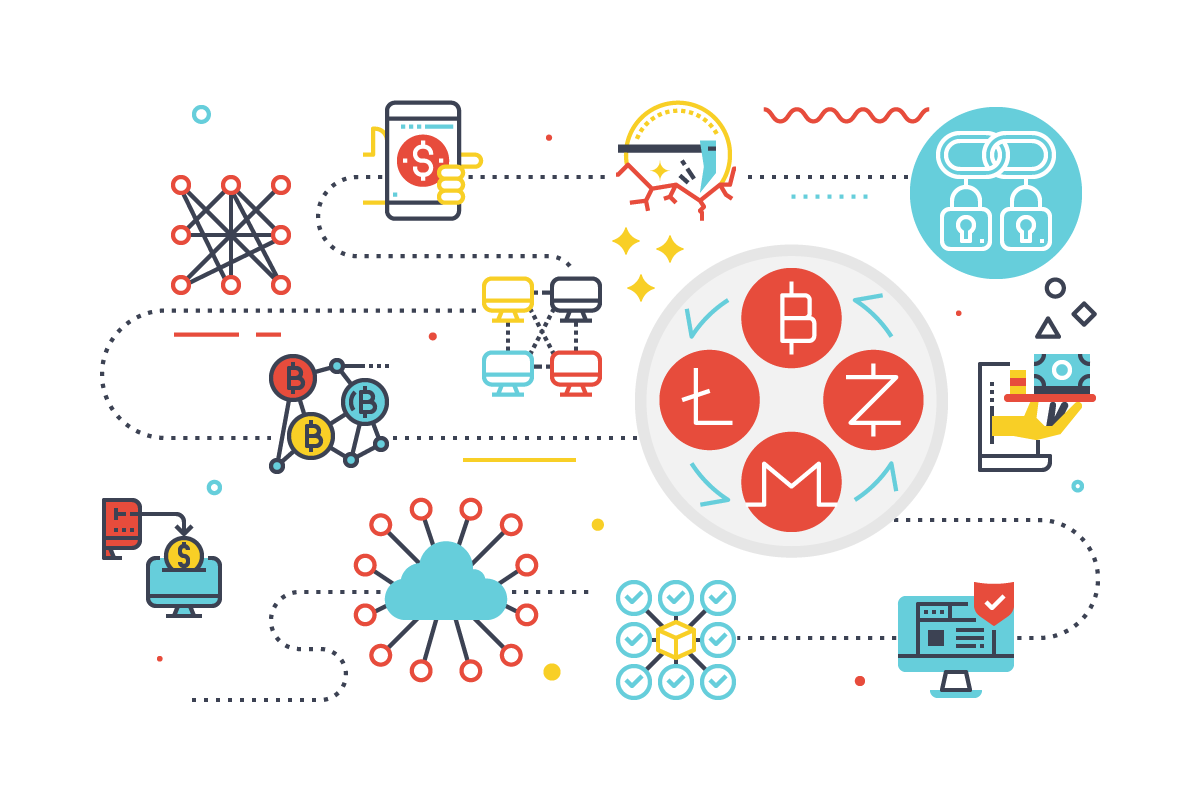
Pingback: Emerging New Cryptocurrencie
Pingback: Is XDAG the Next Dark Horse? | EastShore Mining Devices
Pingback: Introduction of New Cryptocurrency Grin and Beam Based on MimbleWimble | EastShore Mining Devices
Pingback: What's the Charm of DASH? | EastShore Mining Devices